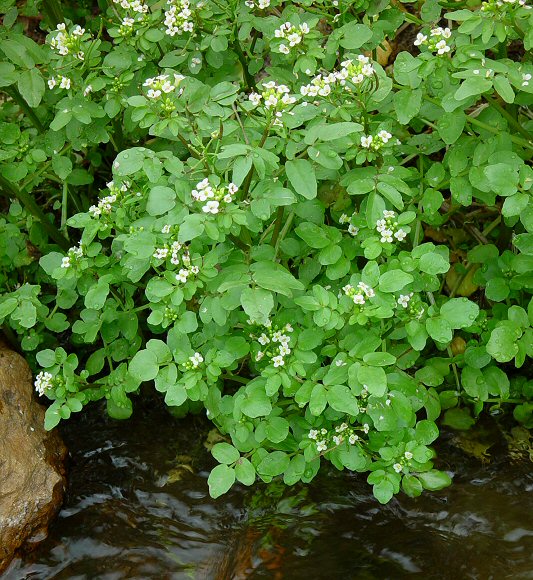Nasturtium officinale W.T. Aiton
Watercress

Introduced
CC = *
CW = -5
MOC = 48
© DETenaglia
Nasturtium officinale W.T. AitonWatercress | |
 |
Introduced CC = * CW = -5 MOC = 48 |
© DETenaglia |
|
Family - Brassicaceae Habit - Rhizomatous perennial forb, usually emergent or floating aquatic, glabrous. Stem - Emergent, submerged, and/or floating stems to 65 cm, rooting at most nodes, herbaceous, glabrous, hollow.
Leaves - Alternate, odd-pinnate, petiolate. Blades 2-10 cm long, petiolate, the bases usually clasping the stem with small, rounded auricles, pinnately compound with 3-9 leaflets, or less commonly simple, especially when plants occur in relatively deep water, the leaflets opposite to subopposite, sessile, oblique at base, linear to irregularly ovate or nearly circular, glabrous, the margins entire, wavy, or with few, shallow, blunt teeth.
Inflorescence - Compact terminal racemes, quickly elongating in fruit to 20 cm. Pedicels glabrous, 2-7 mm long in flower, elongating in fruit.
Flowers - Sepals 4, free, 1.5-2.5 mm long, glabroous. Petals 4, free, 2.5-4.8 mm long, white. Claw to 2 mm long. Limb rounded at apex, 3 mm long, 2 mm broad. Stamens 6, with 4 long and 2 short. Filaments purplish, glabrous, 3.5 mm long. Anthers yellow. Ovary terete, purplish-green, 2.5mm long, glabrous. Styles absent or 0.1-0.5 mm long, persistent in fruit as beak. Stigma 2-lobed, capitate.
Fruits - Siliques 10-15 mm long, straight or slightly arched upward. Seeds mostly 20-50 per fruit, in 2 rows in each locule, 0.9-1.3 mm long, nearly circular in outline, the surface with a coarse, netlike or honeycomb-like pattern of 25-60 ridges and pits on each side, reddish orange to reddish brown.
Flowering - April - October. Habitat - Spring branches and streams, less commonly terrestrial on streambanks or stranded by a receding waterline, and occasionally fens and marshes, ditches. Origin - Native to Eurasia. Lookalikes - Small plants can resemble Cardamine pensylvanica. Other info. - Nasturtium is a fairly common plant throughout the southern half of Missouri but is also found in a few counties north of the Missouri River. It exists to some degree in every state of the continental U.S. with the possible exception of N. Dakota. In Missouri it is most commonly found in spring branches. The plant is recognized by its aquatic habitat, commonly in close proximity to a spring, typically lush growth with numerous inflorescences, pinnate leaves, and brassica-pattern flowers. Photographs taken at the Parkville Nature Sanctuary, Parkville, MO., 5-12-00, and in Iron County, MO., 5-18-03 (DETenaglia); also at Bohigian Conservation Area, Phelps County, MO, 6-23-2023 (SRTurner). |